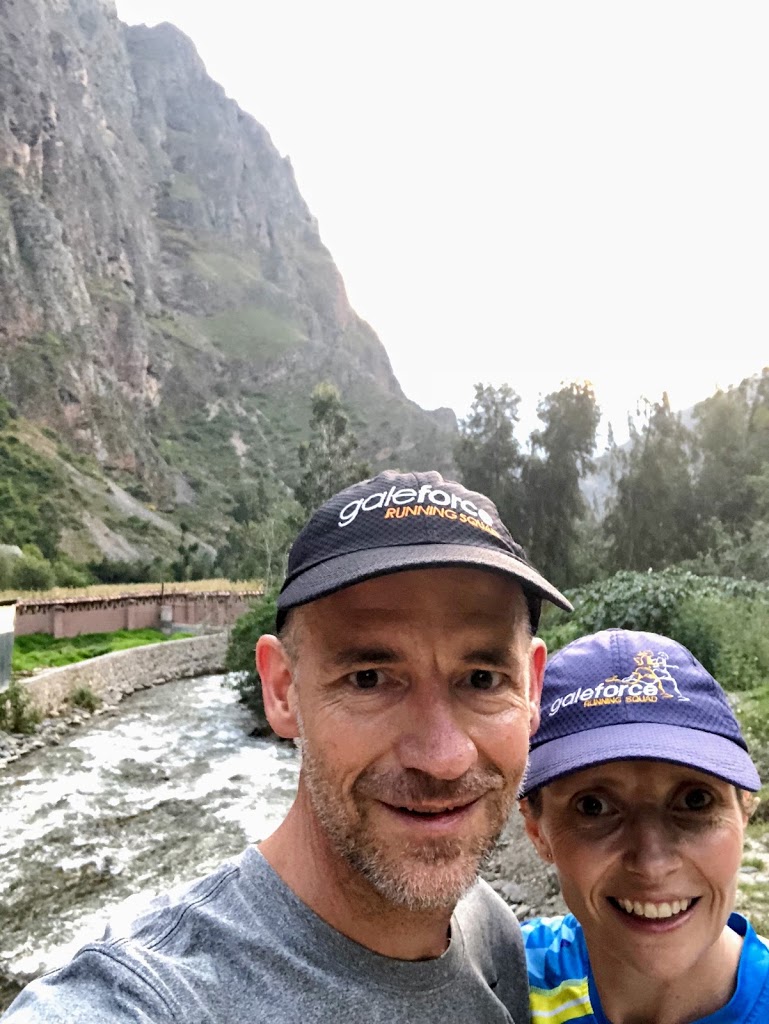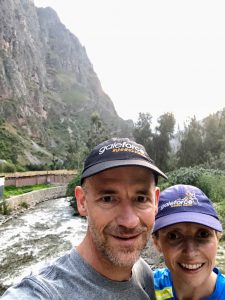We started our day heading to the hills outside of Cusco to the archaeological site of Sasqaywaman. The area was originally built by the Killke culture in about 1100, and then added to by the Incas from about the 13th century. This gave us great views over Cusco, and helped us see ‘El Puma’ – the shape of the Puma that Cusco is based on.
We then joined our mountain biking guides at Yuncaypata, about 3800m. After being kitted up in our helmets and safety vests, and receiving our safety briefing (don’t use the front brake, don’t use the front brake!) we headed off down a mountain track. Day 1 was all about getting familiar and confident with the bike, so that we can do more technical riding on Day 2. I realised it might take more that 1 day to get comfortable with slipping and sliding down a mountain!
Thankfully, we hit the road after a few km, and the terror turned to relief, which confirmed I’m a road girl, not a mountain girl!
Our tour company, G-Adventures is focused on making the world a better place, and via the Planterra Foundation supports local communities to improve their living standards. Our first exposure to this was at the Ccaccaccollo Community and women’s weaving co-op, where G-Adventures helped the community to purchase mechanical looms and alpacas, and provided access to small business training to make their clothing and souvenir business more profitable and sustainable. This supports 700 people from 65 families in the region.
The local ladies showed us how they spin the wool, and dye it will natural products – often starting with a crushed cactus bug that creates a dark purple, which is then mixed with lime juice, sulphate, sodium, and a lumis stone. They also use the colour from flowers and eucalypts. In the end, they have an amazing palette of colour to use in their designs.
By far, the biggest hit was the Alpacas, and a Llama. It’s going to take all our efforts to get home without the girls stashing one in a suitcase.
The fast 15 km descent down a mountain road was awesome with fantastic views of the Sacred Valley and Urubamba River. All in all, the bikes are a great way to explore.
We headed up to the archaeological site of Pisaq (the Partridge) and learned more about the Inca life and economy. They didn’t have money, so their system was built on barter at 3 levels. Firstly, individual reciprocity, which meant they didn’t have a word for ‘thank you’ as materials or work were always given with the expectation of return. Secondly, for the benefit of the community, and thirdly a ‘tax’ payment. It was expected that people would work for 6 months for the greater good, 4 months for their community projects, and then a couple for their own projects. People didn’t receive anything for nothing, land was allocated according to meritocracy (and wasn’t passed down), and wealth was defined by the number of children you had – more kids = greater wealth.
In the mountainside above Pisaq, we could see hundreds of holes – the Inca cemetery. Inca people didn’t believe in death, considering it a transition from one phase of life to another. By placing the bodies in the mountainside in the foetal position they were returning them to the body of Mother Nature.
Lunch was at another G-Adventures Planterra supported community – Parwa Community Restaurant. Again, amazing food made from local produce – potatoes, quinoa, and corn. I had no idea that there were 3333 varieties of potatoes in Peru! Our guide had also collected a roast guinea pig along the way (drive-thru Peruvian style!) which we shared. Very fiddly, and similar texture to duck. Tried it, not in a hurry to have it again!
For the next few nights we’re staying in Ollantaytambo, a village in the Sacred Valley. Andrew and I took the opportunity to get out for a run and see how altitude impacts… it didn’t seem to make a lot of difference to me, which has me wondering whether I actually breathe at home!
Tomorrow is Day 2 of the Mountain biking… will be interesting to see what ‘a bit more technical’ actually means!
Love M & theBunch


Comments are closed